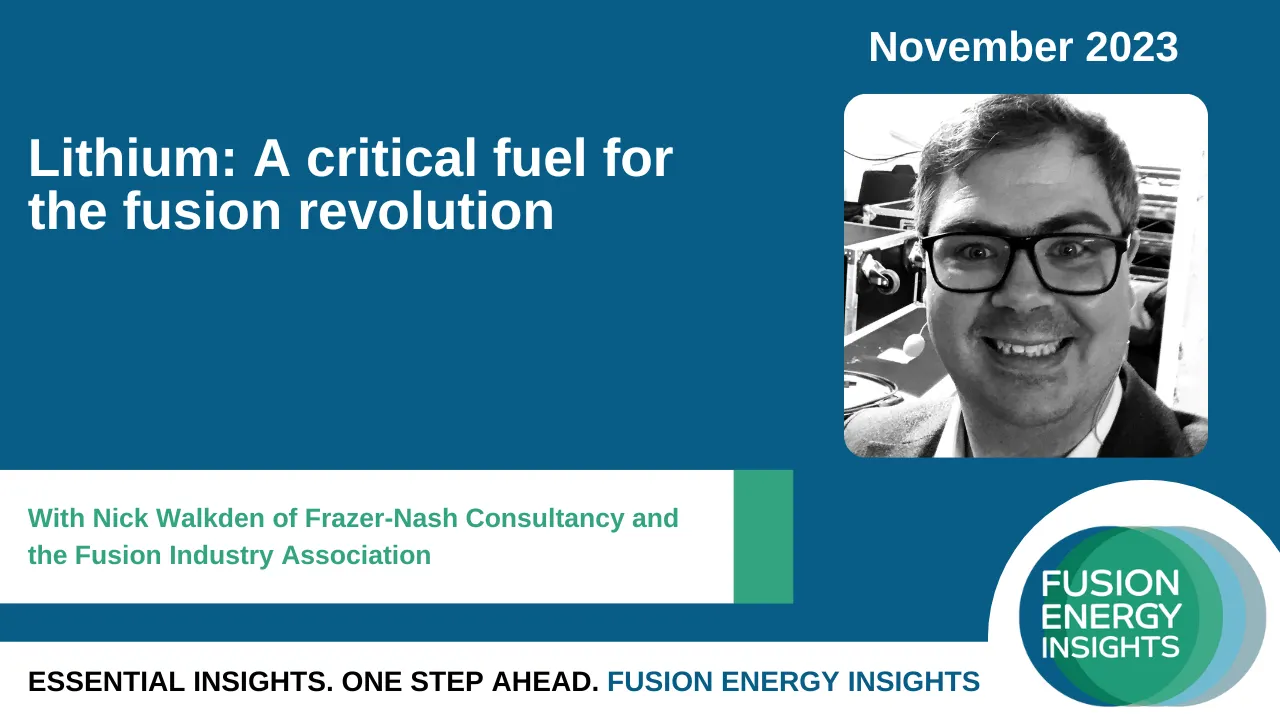Lithium: A Critical Fuel for the Fusion Revolution
In our recent member Q&A session we discussed the vital role of the resource lithium to the commercial development of fusion energy. Our expert was Nick Walkden, the UK Director of the Fusion Industry Association and Lead Fusion Consultant at Frazer-Nash Consultancy Ltd.
Here are three insights from the event…

1. Lithium is a critical resource for fusion for breeding the fuel tritium
As the fusion industry grows with sustained long-term funding from both governments and the private sector, as well as scientific advancements, it is important to consider the role of resources in the development of fusion.
Nick states: “Key materials will be one of the aspects that determines the availability of fusion globally, and lithium is one of these key materials.”
Lithium is a critical resource for fusion because of its material properties. Lithium is used to breed tritium, the key fuel for fusion. Naturally occurring tritium reserves are very low, so tritium will need to be bred to allow the fusion fuel cycle to be self-sufficient. This process is vital for fusion to succeed, which creates a demand from fusion for lithium.
Lithium also has other material properties which make it very important and useful to the fusion industry. Lithium is good at conducting heat so can act as a coolant; it can be used at high temperatures, which improves efficiency; and it is good at slowing down neutrons so performs a shielding function to key components.
Nick says: “If you use it [lithium] cleverly and if you use it well, you can exploit these other properties which are favourable in lithium as well.”
Different companies have different plans for how they will use lithium and the form it will take. Each has benefits and drawbacks.
Lithium can be used in a liquid form as a molten metal or salt, or in a solid form as a pebble, block or ceramic. Research on the best form of lithium to use within fusion reactors is ongoing in public and private fusion programmes.
2. Enriched lithium or natural? It’s a trade-off between resource availability/cost and complexity in system design
Naturally lithium consists of two different types of atom, called isotopes. There’s lithium-6 and lithium-7.
Lithium-6 is better for breeding tritium. The enrichment of lithium means taking a source of lithium and isotopically enriching it so it contains more lithium-6 than would naturally occur.
Presently, there is no supply chain for enriched lithium and the enrichment process consumes a lot of energy.
Public programmes such as STEP and DEMO say they will use enriched lithium, but private companies are targeting concepts that use natural lithium because of the lack of supply chain for enriched lithium (and potential cost).
Neither options are easy. Using natural lithium will require more complexity in system design to ensure that enough tritium can be bred from the natural lithium.
Nick says that “if enriched lithium is used by fusion, then fusion may become a significant percentage of global lithium demand. In order to enrich that lithium, you're going to need a feedstock of lithium that you're enriching, which is going to need to be much bigger than the amount that you're going to be producing at the end.”
Will fusion face competition for lithium with EVs? Probably.
Electric Vehicles (EVs) require lithium in a different form to fusion plants, but it is likely that there will still be competition between lithium for EV batteries and lithium for fusion plants. This is partly due to the fact that both industries are significantly growing at the same time, but this competition might drive innovation for lithium extraction.
3. There are plenty of lithium reserves but not yet the demand to drive down costs
Overall, Nick says: “there is not yet market impetus to solve the resource challenges that lithium may face,” and therefore the problem of demand and supply of lithium may worsen before the market develops to tackle resource supply issues.
Mining of ore for lithium is the traditional way of extracting lithium, but there are other innovative extraction methods under research, for example extraction from seawater and brine.
Nick Walkden: “we shouldn't under-bake the likely competition in the marketplace for lithium,” but we should also see the variety of lithium sources available, for example from mining, innovative extraction methods as well as recycling from previous lithium batteries.
Overall, a plentiful supply of lithium is vital for the commercial roll-out of fusion and the resource is essential to facilitate the self-sustaining reaction to power homes and industry to help diversify the global energy mix away from fossil fuels to renewable and clean forms of power.
There are other materials used in fusion that could face similar resource challenges and it is through partnerships between countries and industries—for example the US and UK major partnership announced on 8th November—which can help to ease resource tensions and stimulate the supply chain.
